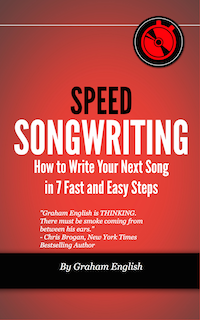
There’s a common myth that creativity only flourishes with absolute freedom.
But the truth is, the opposite is often true: limitations fuel creativity. Learning to embrace constraints can take a songwriter's work to a whole new level.
Here’s why and how limits can boost your creativity, with five examples that show just how powerful they can be.
1. Constraints Make You Find Originality in Familiar Ground
Sometimes, setting a restriction can force you to dig deeper into a common theme and find fresh angles. Instead of starting with a blank page, try limiting your topic.
Let’s say you want to write a love song. “Love” is broad, but what if you narrowed it to “love from afar”? Even tighter: “love from afar during the first snowfall.” Suddenly, you’ve got a setting, a mood, and a unique perspective on the classic theme of love.
Here’s what to do next: Choose a classic theme and add a unique angle to it. You might focus on “heartbreak in a café,” “longing on a rainy train ride,” or “joy on a small-town street.” Set the scene, and let that drive your lyrics. This way, your song won’t just be another love song but a love song set in a distinct, memorable moment.
2. Structure Constraints Keep You from Overcomplicating
It’s easy to get lost in too many options when crafting a song. But putting a structure constraint on yourself, like sticking to two verses and a chorus or deciding on a specific rhyme scheme, forces you to work within a simple framework. This lets you focus more on refining your ideas rather than endlessly adding new ones.
Take the example of the classic 12-bar blues structure. There are only three chords in blues, and verses typically end with a repeated line. While these rules might seem limiting, blues artists have created thousands of iconic, unique songs with this exact structure. The constraint here doesn’t stifle creativity; it gives it a clear path.
Try this: Set a strict structure for your song before you begin. For example, limit yourself to just two verses and a repeating chorus, or choose a specific rhyme scheme (like AABB or ABAB). Stick to it without deviation and see how you can make each line pack a punch within that framework.
3. Limitations Help You Innovate with Instrumentation
Working with a limited number of instruments forces you to find creative ways to achieve a full sound.
For instance, if you limit yourself to just a guitar and a snare drum, you’ll focus more on rhythm, texture, and dynamics to bring your song to life. This type of constraint not only makes your work more creative but also hones your sense of arrangement.
Consider Jack White of The White Stripes, who famously worked with a guitar and drum setup, giving birth to a raw and recognizable sound. By limiting the band’s instruments, he created an edgy, stripped-back vibe that became iconic.
To get started: Choose only two or three instruments for your next song. Try combinations like an acoustic guitar and tambourine or piano and handclaps. Push yourself to create a rich sound using just these tools. You’ll discover new ways to build dynamics and highlight each part of your song with minimal instrumentation.
4. Time Constraints Make You Prioritize the Essentials
Time constraints can often bring out the best in us. When you’re on a deadline, you can’t afford to spend hours tweaking every word or endlessly second-guessing your choices.
Some of the most iconic songs were written quickly, under time pressure. For instance, John Lennon reportedly wrote “Instant Karma” in one day, resulting in a raw and authentic track that resonates with listeners to this day.
Here’s how to try this: Set a timer for 30 minutes and write a complete song within that time. Don’t stop to edit or overthink. Just get the ideas down. Once the timer goes off, take a five-minute break, then review your work. You’ll be amazed by how much you can achieve when you’re forced to focus on what really matters.
5. Creative Constraints Lead to Surprising Word Choices
When you restrict yourself to specific types of words, you’re forced to choose your language carefully, leading to fresh, striking imagery.
For example, you might set a rule for yourself to avoid common words like “love,” “heart,” or “cry” in a song about heartbreak. Doing this allows you to find alternative expressions that capture the emotion in a new way.
Singer-songwriter Joni Mitchell is known for avoiding obvious choices in her lyrics. In her song “A Case of You,” she describes longing with the line, “I could drink a case of you and still be on my feet.” The line avoids clichés and uses a fresh metaphor that feels intimate and unforgettable.
Try this challenge: Pick five words that are “off-limits” in your lyrics. If you’re writing about love, avoid words like “forever,” “baby,” and “miss.” Find fresh words to express these feelings, such as using “empty glass” instead of “broken heart.” This simple exercise can lead to more vivid, unique lyrics that stand out.
Why Embracing Constraints Is a Superpower for Songwriters
Limits aren’t walls to confine you; they’re frameworks that push you to think harder, deeper, and differently. Instead of seeing restrictions as obstacles, approach them as creative prompts. With a focused theme, a specific structure, a couple of instruments, a ticking clock, or a few “forbidden” words, you’re bound to surprise yourself and your listeners.
Now, it’s time to put these ideas into action. Pick one constraint today, whether it’s limiting your theme, setting a timer, or restricting your word choice, and write a song within that boundary. The more you embrace these challenges, the more your songwriting will grow in originality and impact. So, lean into the power of constraints and watch your creativity thrive.

Enter your first name and email address below and click “GET ACCESS NOW!” to get the Speed Songwriting Cheat Sheet delivered to your inbox!
We guarantee 100% privacy. Your information will not be shared.

Leave a Reply